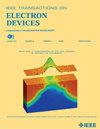钽酸锂与硅和碳化硅基底上的 SH 模式表面声波谐振器比较研究
IF 2.9
2区 工程技术
Q2 ENGINEERING, ELECTRICAL & ELECTRONIC
引用次数: 0
摘要
本研究介绍了基于钽酸锂(LiTaO3 或 LT)/二氧化硅(SiO2)/4H-碳化硅(4H SiC)多层结构的剪切水平(SH)表面声波(SAW)谐振器。碳化硅具有高电阻率(HR)($\rho \gt 10^{{10}}~\Omega \cdot $ cm),能有效抑制寄生表面传导(PSC)效应。通过提取共面波导(CPW)结构中 SiO2/4H-SiC 和 SiO2/Si 衬底的衬底损耗,证明了 4H-SiC 衬底对 PSC 效应的抑制作用。因此,与基于硅衬底的传统 SH SAW 谐振器相比,基于 4H-SiC 衬底的 SAW 谐振器具有更高的品质因数(Q)。使用 4H-SiC 和硅衬底制造的谐振器达到了 Bode- ${Q} _{max }$ 40%。分别为3916和1836,{Q} ${\text {p}}_{\text {p}}$分别为3402和590,导纳比(${Y} _{\text {r}}$)分别为92和74 dB。${Q}基于 4H-SiC 的谐振器的{Q} _{text {p}$ 是基于硅的谐振器的 5.7 倍。用 4H-SiC 衬底代替硅衬底可以提高 Q 值,但不会影响有效机电耦合(${k} ^{{2}}_{text {eff}}$)和频率温度系数(TCF)。为了抑制声表面波谐振器的横向模式,我们制作了不同倾斜角度的倾斜数字间传感器(IDT)。倾斜角度为 12° 的 IDT 能够最有效地抑制横向模式。当使用倾斜 IDT 时,${Q}_{text {p}}_{text/{p}}$,基于4H-SiC衬底的声表面波谐振器超过了硅衬底。与硅衬底相比,4H-SiC 衬底具有更高的 ${Q} _{text {p}}$。_{text{p}}$,使这项技术有望应用于滤波器、振荡器和传感器。本文章由计算机程序翻译,如有差异,请以英文原文为准。
Comparative Study of SH-Mode Surface Acoustic Wave Resonators on Lithium Tantalate With Silicon and Silicon Carbide Substrates
This study introduces shear horizontal (SH) surface acoustic wave (SAW) resonators based on a multilayered structure of lithium tantalate (LiTaO3 or LT)/silicon dioxide (SiO2)/4H-silicon carbide (4H SiC). SiC exhibits high resistivity (HR) (
$\rho \gt 10^{{10}}~\Omega \cdot $
cm), effectively suppressing the parasitic surface conduction (PSC) effect. The suppression of the PSC effect by 4H-SiC substrates is demonstrated by extracting the substrate loss of SiO2/4H-SiC and SiO2/Si substrates in a coplanar waveguide (CPW) structure. Consequently, SAW resonators based on 4H-SiC substrates demonstrate a superior quality factor (Q) compared to the conventional SH SAW resonators based on Si substrates. The fabricated resonators with 4H-SiC and Si substrates achieved Bode-
${Q} _{\max }$
of 3916 and 1836,
${Q} _{\text {p}}$
of 3402 and 590, and admittance ratios (
${Y} _{\text {r}}$
) of 92 and 74 dB, respectively. The
${Q} _{\text {p}}$
of the 4H-SiC-based resonator is 5.7 times higher than that of the Si-based resonator. Substituting the Si substrate with the 4H-SiC substrate increases Q without compromising the effective electromechanical coupling (
${k} ^{{2}}_{\text {eff}}$
) and temperature coefficient of frequency (TCF). To suppress the transverse mode of the SAW resonators, tilted interdigital transducers (IDTs) at various titled angles were fabricated. A 12° tilt angle IDT demonstrated the most effective transverse mode suppression. When the tilted IDT was employed, the
${Q} _{\text {p}}$
of the SAW resonator based on the 4H-SiC substrate surpassed that of Si substrate. Compared to the Si substrate, the 4H-SiC substrate resulted in a higher
${Q} _{\text {p}}$
, making this technique promising for application in filters, oscillators, and sensors.
求助全文
通过发布文献求助,成功后即可免费获取论文全文。
去求助
来源期刊

IEEE Transactions on Electron Devices
工程技术-工程:电子与电气
CiteScore
5.80
自引率
16.10%
发文量
937
审稿时长
3.8 months
期刊介绍:
IEEE Transactions on Electron Devices publishes original and significant contributions relating to the theory, modeling, design, performance and reliability of electron and ion integrated circuit devices and interconnects, involving insulators, metals, organic materials, micro-plasmas, semiconductors, quantum-effect structures, vacuum devices, and emerging materials with applications in bioelectronics, biomedical electronics, computation, communications, displays, microelectromechanics, imaging, micro-actuators, nanoelectronics, optoelectronics, photovoltaics, power ICs and micro-sensors. Tutorial and review papers on these subjects are also published and occasional special issues appear to present a collection of papers which treat particular areas in more depth and breadth.
 求助内容:
求助内容: 应助结果提醒方式:
应助结果提醒方式:


